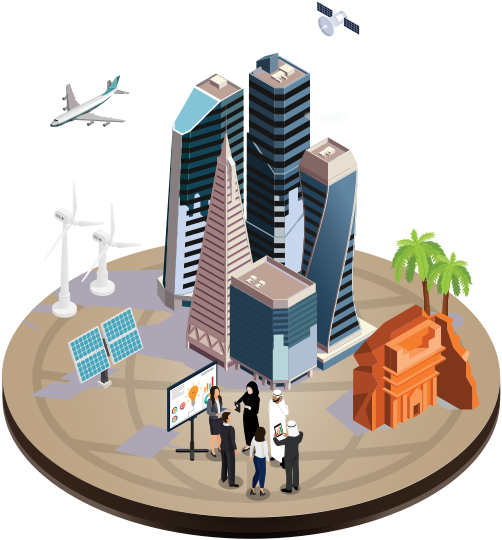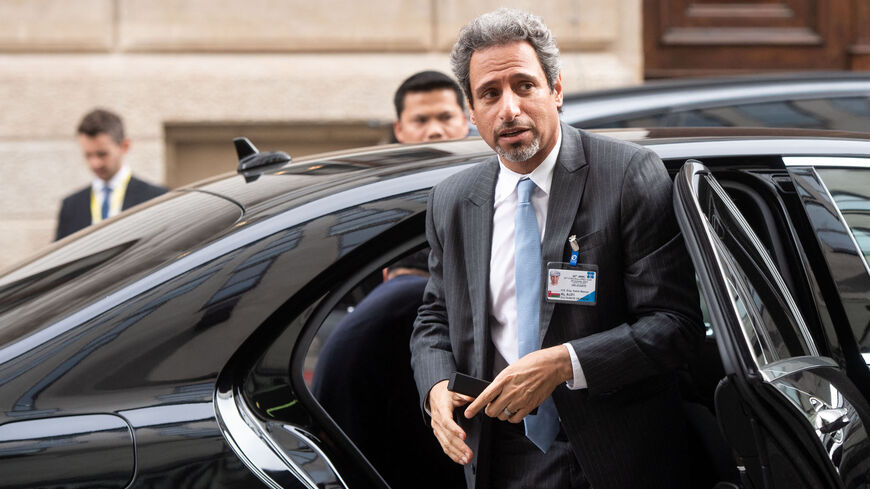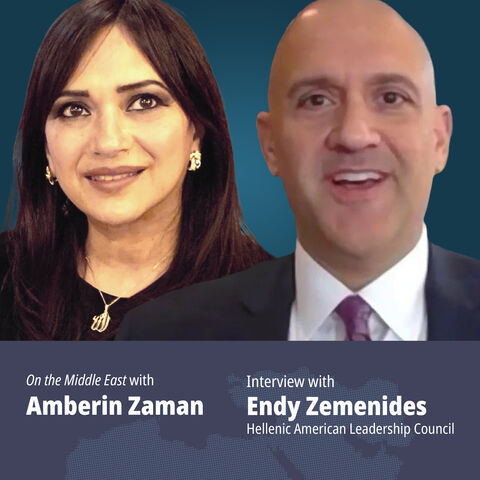Oman’s energy sector, with its emphasis on renewables and clean hydrogen, remains the key driver of the country’s economic progress, complementing far-sighted public sector and fiscal reforms that have shaped the country’s turnaround since the COVID pandemic.
“It doesn’t have to be oil and gas,” said Salim Al Aufi, Oman’s Minister of Energy and Minerals, in an exclusive interview with Al-Monitor. “We are also embarking heavily on renewable energy and hydrogen.”
Al Aufi discussed a diverse energy development portfolio that also includes wind, solar, geothermal and tidal energy sources.
“They all will contribute, and that's really our contribution toward providing a sustainable source of energy,” he said. “Oman is blessed with all these different options.”
Oman is making an especially significant investment in and commitment to hydrogen.
Green hydrogen “is as clean as you can get,” said Al Aufi, who was appointed minister by Sultan of Oman Haitham Bin Tarik in June 2022. “But we're also working quite aggressively on reducing our carbon footprint with regards to oil and gas activities, in transportation and so on.”
Asked if Oman expects to meet its targets for development and export of hydrogen and ammonia, Al Aufi replied, "Absolutely.”
“We have been signing a number of MoUs with countries in Europe and in the Far East,” he explained. “All of that seems to be going in exactly the way that we planned it and sometimes it's even slightly better."
Oman’s energy sector has been instrumental in the country’s recent economic progress. Oman’s economy contracted two years in a row, from 2019-2020, and struggled with significant debt. But a far-sighted reform program under Haitham, who came to office in January 2020 following the death of his cousin and predecessor Qaboos bin Said, combined with a robust and diversified energy strategy have led to what will be three straight years of robust growth, making Oman an increasingly attractive destination for foreign investment.
Al Aufi is optimistic that Oman can sustain its economic progress despite the possible impact of a global economic recession on oil prices.
“I think the cushion is pretty conservative and solid,” he said, referring to Oman’s projected price of $55 per barrel for the 2023 budget (the current price of oil is around $75 per barrel). He added, “We can only control our cost. We can't control the market price. So our cost has to be very resilient and should be able to continue supplying the energy market even at low oil prices, and that's our objective.”
“I think we stand at a very good position,” he said, adding, “Even if oil prices dropped to $30 or $25 per barrel, we should be able to continue producing. “
Al Aufi is bullish on Oman’s potential for clean energy and renewables, including wind and solar.
“What we've done last year, since the beginning of last year, is really identify all the potential areas for high solar and wind combined locations, and that's because we think that is the winning horse to get the lowest possible levelized cost of producing renewable energy, to be able to produce it in an area where wind and solar coexist,” he said.
Al Aufi said the investment environment is “absolutely open” for both local and international players in Oman, who are treated “in exactly the same manner” in the auction and bidding process. He explained that there tend to be more “international consortiums with extremely strong developers in the mix. So that's why we are feeling a little bit upbeat and quite pleased with the outcome so far.”
A lightly edited transcript of the interview follows.
Al-Monitor: Oman will post an estimated $3 billion surplus in 2022, compared with a deficit in 2021. Heading into COVID, Oman’s economy seemed shaky, suffering a 1.1% contraction in 2019 and a 3.2% decline in GDP in 2020. The economy is now on pace a projected 4.4% growth last year, after 3% in 2021. What role has energy played in this turnaround in Oman’s economy?
Al Aufi: Quite a bit actually. As you know, oil and gas contributes quite significantly to the national income of the country and it's the main driver for the economy. So the improved oil and gas prices contributed significantly. Of course, that's not the only contribution. The other contribution came from the government’s actions with regards to the level of spending and the more focused activities toward where the level of spending should be directed, and so on. In addition to the other measures with regards to removal of some subsidies, particularly the fuel and electricity [subsidies], and the introduction of tariffs, particularly the value added taxes and the improvement in some of the taxes that the government is normally taking. But the significant contribution did come from oil and gas, improved pricing for oil and improved pricing for gas, and the excellent performance of this sector in terms of production.
Al-Monitor: How has Oman’s energy policy supported the Medium-Term Fiscal Plan (MTFP) and broad public-sector reforms in 2020 that have allowed this turnaround – besides the obvious advantage of high oil prices? And can you sustain these efforts even if there is more price volatility in energy markets?
Al Aufi: The pricing set for oil price in the budget is at $55, as an average for this year, 2023, which is considered to be an acceptable level, and it's a quite conservative position considering we are at about $75 to $80 as we enter the year. And of course, Oman sells its crude two months in advance. So we already have pricing for January and pricing for February, and the January-February pricing is averaging around $75 plus per barrel. That of course, doesn't mean it can’t go down. There are still chances that it does, but I think the cushion is pretty conservative and solid. Even with that, there is a small deficit that the government is trying to close using either loans or more aggressive control on the spending and so on.
But we think it's quite a healthy position, and that's really how the oil and gas sector is supporting the fiscal plans for '23. Gas seems to be on strong ground, so we're using of course the same index for oil, but gas seems to be going quite stronger in that regard. So both oil and gas seems to be on a good track to support the government policies and actions to try and reduce the total deficit and of course, close out the gap between the total level of borrowing and what the government have to pay back in terms of principles and interest. In addition to, of course, working on all the other sectors, be it tourism, logistics industries and so on, but the main contributor is coming still from oil and gas activities.
Al-Monitor: You have said that energy must be affordable, sustainable, and climate friendly --- how does Oman seek to achieve this balance?
Al-Aufi: In the affordability, of course, supplying energy at the lowest possible cost, and that's an area that we work in. We can only control our cost. We can't control the market price. So our cost has to be very resilient and should be able to continue supplying the energy market even at low oil prices, and that's our objective, that's our mission. That's why we continue challenging all the operators in terms of their activity levels and spend and so on. I think we stand at a very good position. Even if oil prices dropped to $30 or $25 per barrel, we should be able to continue producing. And of course, that will limit how much is left to go into the government books. But in terms of being able to produce and be able to cover our operating cost and our spend level, we should be able to operate at that level.
Of course, if we start cutting the activities, we should be able to operate at a much lower pricing .
That's the affordability part.
The sustainability is being able to look at all the different options available to us. We do have oil, we do have gas, we do have renewable energy. We are looking very seriously into the potential of geothermal and tidal, where Oman is blessed with all these different options.
So from a sustainability point of view, we are looking into all the different options available so that we can continue supplying energy to the world. It doesn't have to be oil and gas. We are also embarking heavily on renewable energy and hydrogen. We are looking into, as I said, geothermal and tidal. They all will contribute, and that's really our contribution toward providing a sustainable source of energy.
The challenges of course, we face with renewable energies, can we store a day sunlight to an evening production? And that's a challenge that not only Oman is facing, but globally. And we are working with many global institutions, companies, universities and so on, to try and find attractive solutions beside the lithium batteries, and the usual ones, so that we can provide sustainable energy throughout.
And the last part is clean -- clean in the sense that we are embarking heavily on renewable energy and we're embarking on hydrogen, green hydrogen, which is as clean as you can get, but we're also working quite aggressively on reducing our carbon footprint with regards to oil and gas activities, in transportation and so on.
So we're trying to supply the cleanest possible energy to the global market, and to the local market. But we are not saying that we will stop producing oil and gas, but we will make our carbon footprint for producing oil and gas as low as it can possibly be.
And that's of course, introducing renewable energy into the oil and gas activities, replacing some of the existing processes so that we introduce much cleaner and greener technologies to help us continue producing, reducing our transportation footprint by being more efficient and more effective.
These are the pillars for the three messages: affordable, sustainable and clean.
Al-Monitor: You spoke just now about the development of green hydrogen. You set a goal of at least a million tons by 2030 and you said that you expect $20 billion to be invested in green hydrogen and ammonia, the ammonia industries. Tell us more about that? Do you see eventually hydrogen in particular and ammonia as viable energy exports?
Al Aufi: Absolutely.
Al-Monitor: And do you expect that investment to be on target in the coming years?
Al Aufi: Absolutely. What we've done last year, since the beginning of last year, is really identify all the potential areas for high solar and wind combined locations, and that's because we think that is the winning horse to get the lowest possible levelized cost of producing renewable energy, to be able to produce it in an area where wind and solar coexist. And we were blessed by a vast area in the southern part of Oman and of course the shore of Oman where wind and solar exist in the same location. So we invested a lot of time last year to try and identify the maximum potential area, clear it from any potential interfaces with regards to urban development or environmental protected zones. And we were able to identify quite a sizable land that we have started dividing into smaller blocks and auctioning to the global market.
And actually, our first auction was launched late October, early November with two potential blocks. And the interest so far seems to be very strong. Over 50 companies have already submitted their RFQ [Request for Quote] so that we can check the viabilities, technical capabilities and financial capabilities of these developers. The RFP [Request for Proposal] was issued two weeks back, and so far, up to four consortiums have bought the RFP. We're expecting to receive some bids sometime later this month so that we can evaluate them. And hopefully, with all the information already given to the developers and intensive discussion that have taken place last year, we should be able to sign some agreements before the end of this quarter.
Now, that’s of course the bidding process or the auction process. In parallel, we have legacy projects that have been already discussing with us some land potential early last year. And we have accepted to run these legacy projects in parallel with the auction process so that we can create anchor projects to drive investment in the country and increase the interest in the production of renewable energy and hydrogen. We have been signing a number of MOUs with countries in Europe and in the Far East so that we start securing some off-takers, and also introducing the potential of renewable energy and hydrogen and ultimately ammonia for export from Oman.
So all of that seems to be going in exactly the way that we planned it and sometimes it's even slightly better. So we are quite confident that we should be able to sign some agreements hopefully in the first quarter of this year.
Al-Monitor: Tell us about the role of the Ministry of Finance, Energy Development Oman organization in managing government investments in oil, gas and renewables?
Al Aufi: The Ministry of Energy is the policymaker and the regulator for renewable energy and… for the hydrogen economy. So our role is pretty much identify the land, agree on the rules of the investment, and then hand over the potential land to Hydrogen Oman company so that they can start marketing the blocks to the global market and negotiating the commercial terms with the potential developers ending with the signing of a sub user …between Hydrogen Oman (Hydrom) , and the potential developer stating exactly what the terms and conditions are in terms of the duration of the term, the nature of the integrated project from renewable energy ultimately to maybe ammonia or hydrogen plus industry, the royalties that will be given to the government as part of this process, the taxation systems and so on.
So there are actually two players in this... Three players, I would say. The first one is the Minister of Energy and Minerals as the policy and strategy for the overall economy of the hydrogen economy. The second one is Hydrogen Oman as the orchestrator of the entire process, be it the auction process or the legacy process. And finally the developers and some of the developers are also local companies like OQ, which is 100% owned by the government. So this is the structure. The Ministry of Finance doesn't really play a major role, except they are involved in the discussion when we finalize the commercial [terms] with the developers.
Al-Monitor: And given the reforms and the projects we've been talking about, what are the possibilities for foreign investors and foreign ownership of Omani assets in the energy sector?
Al Aufi: It's absolutely open. It's actually the auction process we offer to international developers and Omani developers. The majority of the companies that have submitted their RFQ are international companies with or without local partners. And if they have a local partner, then they form a consortium. If they don't have a local partner, they're absolutely free to come and bid on their own. We do our due diligence to all the potential developers, be it local or international, in exactly the same manner. So we don't distinguish, we set them both against the same requirement and the same rigor check. So the investment environment is really open for local as well as international players.
Al-Monitor: Are you bullish on the global economy and Oman's role in it, given some of the headwinds that have been indicated by the IMF and others? Just today, the Head of the IMF, Kristalina Georgieva said that a recession could hit one third of the world in 2023.
Al Aufi: Potentially there is. I think that will probably affect '23 and '24. It'll not affect the renewable energy projects because they tend to be more long-term. This year is going to be more of signing the agreements, starting to collect all the data required for the project and so on. I don't expect any project will get into FID [Final Investment Decision] before next year or maybe even '25. We are not expecting any production to start before 2030. So the immediate recessions that are happening globally will not have a major impact on the renewable energy projects because they tend to be a little bit more long-term. It may have some impact on the potential oil and gas activities if the global economies start to slow down and that of course will result into lower demand for oil and lower activity level.
We've seen this before. Our strategy has always been to stay resilient, don't change the activity level as much as possible because we want to bounce back strong when the markets start to recover. But I don't see it affecting so much the renewable energy economy as we are currently developing.
Al-Monitor: Thank you, Mr. Minister, is there anything else you would like to share with our readers?
Al Aufi: I think I've given you enough information with regards to the number of bids for the renewable energy and they tend to be more of international consortiums with extremely strong developers in the mix. So that's why we are feeling a little bit upbeat and quite pleased with the outcome so far. If the outcome would have been slightly different, I would have been hesitant to sound as positive as I am right now.







